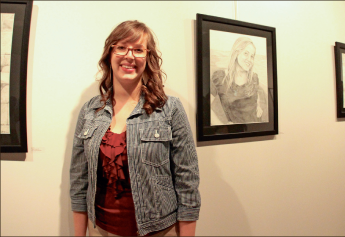Arts provide balanced education
From Mozart to Beethoven, Donatello to Leonardo and Shakespeare to Andrew Lloyd Webber, the arts, according to several ground-breaking studies, are beneficial to a well-rounded educational experience for students of all ages.

Liberty arts — Liberty incorporates the arts into education through programs like “Echoes &Whispers.” Erin McCool is presenting at the show. Photo credit: Alyssa Bockman
In an article published by the New York Times, a study by New York City’s Education Department professed that the New York City high schools with the highest graduation rates were positively correlated with having the most access to arts education.
The study, which can be found at caenyc.org, found that one third of students who took three or more classes in the arts were more likely to be found in the schools with higher graduation rates than students in schools with lower graduation rates.
“Given the national studies in which at-risk students cite arts participation as their reason for staying in school, increasing course offerings in the arts in the low-graduation schools is likely to be an effective way to improve student engagement at those schools,” the study stated.
According to Kent City Schools in Michigan, James K. Davis, having a degree in music education, feels that an education in the arts, especially that of music, provides the best opportunity to nurture relationships that teach students more than just basic knowledge or facts. Music is knowledge to be learned, Davis said, but it also gives students the ability to train emotional expertise, teamwork, accountability and an appreciation of others.
“I see band frustrating students in a way that helps them create solutions to problems. Band helps us overcome adversity while taking the time each day to be thankful for each other. Band expands students’ minds to think bigger,” Davis said.
Students who have already gone through the trials of public education, such as Kristina Benham, a college student at Liberty University who is majoring in history and is currently working on a minor in music, state that education in the arts has taught them skills that were applicable to all areas of study, but were only learned in art classes.
Benham said her music classes in college have been beneficial in teaching her discipline, the realization that there is always room for improvement and that without enjoyment, she cannot do her best.
“Music brings out the quality of my work rather than just the quantity of a grade,” Benham said.
Priscilla Nazarijchuck, a 2009 high school graduate currently studying to become a better dancer, feels that arts benefit education by providing a purpose for students. She stated that they give students an outlet to express themselves and an opportunity to explore their personal creativity.
“I think art makes students see the world in a completely new and different way,” Nazarijchuck said.
According to Nazarijchuck, classes centered in art education and development are the only reason some students continued their education at her high school.
“A lot of those kids only enjoy that one class, and it’s the reason they wake up in the morning,” Nazarijchuck said.
In an interview, Al Coleman, the assistant superintendent for curriculum and instruction for Lynchburg City Schools in Lynchburg, Va., stated that the only time art classes are dropped from the curriculum is when enrollment is too low.
“Budget restrictions of 15 to 20 percent have affected elective and exploratory offerings,” Coleman said.
Leigh Farmer, the public information officer for Lynchburg City Schools, stated that interest plays a big role in whether or not a class is added to the curriculum.
“The student interest, as a result of registration, for these classes determines whether they are actually taught in any given semester,” Farmer said.
The arts and extracurricular classes offered at Lynchburg City Schools, according to their Program of Studies catalogue, include classes such as music, drama, newspaper, yearbook and athletic training.
In 2010, roughly 82.5 percent of students in the Lynchburg, Va. area as a whole graduated on time, according to the Virginia Department of Education. Jefferson Forest High School had the best graduation rates at 96.1 percent. Classes at this high school include an advanced placement (AP) course in music theory, theatre, art and band.
“We are very proud of the success our students have demonstrated in the arts,” Coleman said.
The economic crisis in the US paired with the lack of enrollment currently being seen in school systems does not affect only the students when it comes to courses being offered. Teachers of these courses outside the core curriculum are being laid-off due to budget restrictions many schools face.
“Enrollment affects budget decisions related to any cutbacks in any area … these cuts have resulted in slightly higher teacher-student ratios in core classes,” Coleman said.
On Sept. 29, the United States House of Representatives Committee on Appropriations released the Draft Fiscal Year 2012 Labor, Health and Human Services funding bill. The bill includes information regarding future plans to fund programs within the Department of Education and other related agencies. The bill includes plans to raise funding for several education programs already in place in the public school system. However, according to the National Guild for Community Arts Education, a possible cut to federal arts education funding, at a total of $27.2 million, could be one of the implications to the bill.
The claim is that the arts are able to foster creativity, a trait essential to inventors of all trades. With cutbacks in art education, many of the young minds who would otherwise be exposed to arts and have the ability to experiment within the realm of imagination would never be able to explore the cornucopia of activity, experience and knowledge the arts offer.
